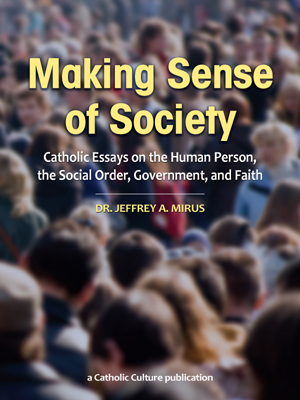A Eucharistic miracle when Bergoglio was an auxiliary bishop
By Dr. Jeff Mirus ( bio - articles - email ) | Dec 17, 2019
The future Pope Francis investigated a Eucharistic miracle that took place in Buenos Aires in 1996. I learned of this just the other day, when we received a fund appeal which included a report on “Eucharistic Miracles” from the newsletter of Saint Joseph de Clairval Abbey in France. The report cites scientific evidence which links this miracle to the more famous one in Lanciano, Italy around 750 AD—and by inference to all Eucharistic miracles.
Back in the mid-1980s, I had occasion to read about many Eucharistic miracles. Trinity Communications used to publish printed books, and we also helped Bob and Penny Lord of Journeys of Faith to prepare and print their first of two books surveying Eucharistic miracles throughout history, which was entitled This is My Body, This is My Blood. But all of this was before the Buenos Aires miracle, and I have not kept up with developments since that time.
Many readers will doubtless already know about the 1996 miracle. There is quite a bit of information about it on the Internet. I also notice that another possible miracle was claimed in Buenos Aires in 2017, but I haven’t looked into it closely. In contrast, there has been a thorough study of the 1996 miracle, and two aspects of it immediately caught my attention. The first is merely tangential, a matter of current interest: The future Pope Francis initiated the investigation. The second is more significant: According to the report I received, it has been scientifically established that the heart tissue from the Buenos Aires miracle belongs to the same person as the flesh and blood at Lanciano.
Here, then, is what took place in the parish of Santa Maria y Caballito Almagro, in the commercial district of Buenos Aires:
On August 18, 1996, Fr. Alejandro Pezet had just finished distributing Communion when a woman told him there was a discarded host in the back of the Church. Fr. Pezet recovered the host, placed it in a container of water, and placed the container in the tabernacle. On August 20th, he discovered that this host appeared bloody, so he informed the auxiliary bishop, Jorge Bergoglio.
Bishop Bergoglio decided to have the host photographed. The photographs, taken on September 6th, show that the host had grown in size and had the appearance of a piece of bloody flesh. After three years, when there was no decomposition of this apparent flesh, Bishop Bergoglio decided to have it scientifically analyzed. The testing began in October of 1999.
In 2005, Dr. Frederic Zugibe, a cardiologist and forensic pathologist, announced his findings:
The analyzed material is a fragment of the heart muscle found in the wall of the left ventricle, close to the valves. This muscle is responsible for the contraction of the heart. The left cardiac ventricle pumps blood to all parts of the body. The heart muscle is in an inflamed state and contains a large number of white blood cells. This indicates that the heart was alive at the time the sample was taken. I affirm that the heart was alive, since white blood cells die outside a living organism; they require a living organism to sustain them. Thus, their presence indicates that the heart was alive when the sample was taken. What is more, these white blood cells had penetrated the tissue, which further indicated that the heart had been under severe stress, as if the owner had been beaten severely about the chest.
The tests were witnessed, but Dr. Zugibe did not know the origin of the sample. After he submitted his findings, he was told that the sample was taken from tissue found in 1996. Zugibe responded:
You have to explain one thing to me: If this sample came from a dead person, how could it be that while I was examining it, the cells of the sample were moving and pulsating? If the heart came from someone who died in 1996, how could it still be alive?
It was only at this point that Zugibe learned that the sample came from a consecrated host. He exclaimed: “This will remain an inexplicable mystery to science—a mystery totally beyond her competence.”
Note that similar statements have been made about the liquefied blood in the regularly recurring miracle at Lanciano. That blood has been clinically determined to react in tests the same way as does the blood in living persons. An extensive study of the Lanciano material was released in 1976, after being confirmed by a scientific commission appointed by the World Health Organization.
Since then, several experts have compared the lab reports relating to the samples from both Buenos Aires and Lanciano, and have determined that the two samples came from the same person. We also know that the blood type in both cases is the same as that of the blood which soaked into the Shroud of Turin.
All comments are moderated. To lighten our editing burden, only current donors are allowed to Sound Off. If you are a current donor, log in to see the comment form; otherwise please support our work, and Sound Off!








